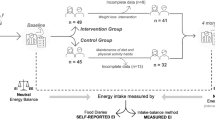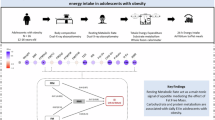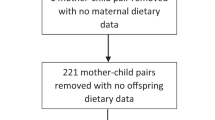Abstract
OBJECTIVE: To determine the phenotypic and dietary characteristics of energy underreporters in a healthy population of middleaged women using accurate body composition measures.
DESIGN: Cross-sectional study of 436 healthy middleaged female volunteers, unaware of any hypotheses regarding diet and body fat: mean age 58 y (39–70 y), body mass index (BMI) 24.3 kg/m2 (17.0–41.9 kg/m2). The prevalence of overweight (25.0>BMI>29.9 kg/m2) and obesity (BMI>30 kg/m2) were 30% and 5% respectively.
MEASUREMENTS:Dietary intake by food frequency questionnaire (FFQ) (n=436), 197 subjects also completed seven-day food records; body composition by dual energy X-ray absorptiometry (DXA); physical activity by standardised questionnaire. Underreporters were subjects whose estimated energy expenditure (EE) exceeded reported energy intake (EI). Three cut-off levels of underreporting were determined from estimates of EE utilising DXA body composition measures: basal, and two including EE from physical activity (using the ratio 1.35 or ratios from reported physical activity level).
RESULTS: Underreporters had significantly greater weight (P<0.01), BMI (P<0.01), total fat P<0.05), fat free mass (P<0.0001), but not adiposity (% body fat) than adequate-reporters, at each of the three cut-off levels. Underreporters reported significantly lower intakes of energy and all macronutrients (P<0.0001). Expressed as a percentage of EI, the reported diet of underreporters was significantly lower in fat, similar in carbohydrate and higher in protein. Similar results were found with seven-day food record data, although reported intakes from these were significantly lower than those from FFQ.
The prevalence of underreporting was highest in obese subjects (defined by BMI only), with up to 65% of these subjects underreporting EI and in the highest BMI tertile (prevalence of 57%). In those with BMI<24.9 kg/m2, the maximal prevalence rate of underreporting was 43%. Importantly, however, the rates of underreporting were similar between tertiles of adiposity. Most (68%), but not all, underreporters were found in the lowest tertile for reported EI.
CONCLUSIONS: A low reported EI and greater BMI may help identify energy underreporters. However, whilst underreporters may more frequently be ‘`bigger’ (by BMI), they are not necessarily fatter (using direct measures of body fat). As underreporting was present among all tertiles of BMI and adiposity, these results emphasise the importance of following past recommendations to identify and exclude energy underreporters in nutritional studies. Where underreporters have not been excluded, reported nutrition-disease relationships must remain in doubt.
This is a preview of subscription content, access via your institution
Access options
Subscribe to this journal
Receive 12 print issues and online access
$259.00 per year
only $21.58 per issue
Buy this article
- Purchase on SpringerLink
- Instant access to full article PDF
Prices may be subject to local taxes which are calculated during checkout
Similar content being viewed by others
Author information
Authors and Affiliations
Corresponding author
Rights and permissions
About this article
Cite this article
Samaras, K., Kelly, P. & Campbell, L. Dietary underreporting is prevalent in middleaged British women and is not related to adiposity (percentage body fat). Int J Obes 23, 881–888 (1999). https://doi.org/10.1038/sj.ijo.0800967
Received:
Revised:
Accepted:
Published:
Issue date:
DOI: https://doi.org/10.1038/sj.ijo.0800967
Keywords
This article is cited by
-
Effect of hereditary haemochromatosis genotypes and iron overload on other trace elements
European Journal of Nutrition (2013)
-
Under-reporting of energy intake in elderly Australian women is associated with a higher body mass index
The Journal of nutrition, health and aging (2013)
-
Contribution of Midparental BMI and Other Determinants of Obesity in Adult Offspring
Obesity (2008)
-
Racial Differences in Correlates of Misreporting of Energy Intake in Adolescent Females
Obesity (2006)
-
Effect of Screening Out Implausible Energy Intake Reports on Relationships between Diet and BMI
Obesity Research (2005)



